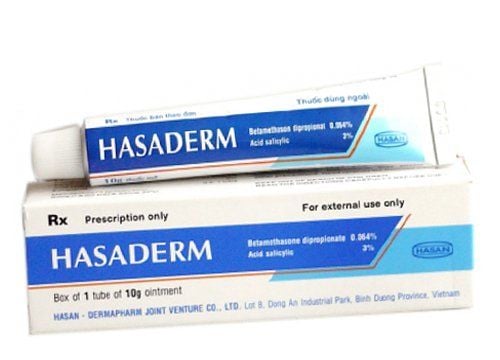This is an automatically translated article.
Bactroban medicine containing the main ingredient is mupirocin indicated in the treatment of local skin infections. Let's learn about the uses and notes when using Bactroban through the article below.
1. What are the effects of Bactroban?
“What is Bactroban?” Bactroban drug is prepared in the form of topical ointment, indicated in the treatment of primary and secondary local skin infections as follows:
Primary infections: Folliculitis, impetigo, boils, impetigo; Secondary infections: Eczema superinfections, infected traumatic lesions such as insect bites, skin abrasions, minor wounds and minor burns; Prophylaxis of infection: Bactroban topical can be used in the prevention of bacterial infection in small wounds, prevention of infection in cuts and abrasions... About pharmacodynamics
Active ingredient mupirocin is antibacterial The antibiotic is extracted from Pseudomonas Fluorescens, antibacterial activity against most bacteria causing skin infections such as Staphylococcus aureus, Streptococcus, Escherichia coli, Haemophilus influenzae.
Pharmacokinetics
Bactroban ointment, after applying to the skin, has a local effect, only a very small amount of the drug is absorbed into the body. The amount of drug absorbed into the body is rapidly metabolised to the inactive metabolite, monic acid, and is rapidly excreted by the kidneys.
2. Dosage of Bactroban ointment
The dose of Bactroban used depends on your age and medical condition. The recommended dose of Bactroban is as follows:
Adults and children 2 months of age and older with impetigo caused by S.pyogenes and S.aureus: Apply the medicine to the infected skin 3 times/day, duration of use. recommended medicine for about 5 - 10 days; Adults and children 3 months of age and older with secondary skin infections: Apply Bactroban to the infected skin 3 times a day, the recommended duration of use is not more than 10 days; Bactroban is a topical ointment, the patient needs to apply a small amount of the drug to the damaged skin (can bandage the damaged skin in case of need). Do not mix the drug with other preparations due to the risk of dilution that reduces the antibacterial effect, destabilizing the active ingredient mupirocin in the ointment.
3. Bactroban topical side effects
Bactroban ointment can cause some side effects as follows:
Burning at the application site; Redness, itching, dryness and stinging sensation at the application site; skin reactions due to sensitivity to mupirocin or to the excipients; Whole body allergy. In case of experiencing side effects, the patient should stop using Bactroban and notify the treating doctor for timely treatment.
4. Notes when using Bactroban ointment
Contraindicated in patients with hypersensitivity to mupirocin or to any component of Bactroban. Hypersensitivity reactions or severe local irritation to the drug have rarely occurred. In case of experiencing the above reactions, the patient should stop treatment, clean the drug at the application site and notify the treating doctor to be replaced with an appropriate anti-infective drug. Prolonged use of Bactroban may increase the risk of proliferation of non-susceptible organisms. In which, pseudomembranous colitis was recorded when using antibiotics, the severity ranged from mild to life-threatening. Therefore, it is important to consider this risk in patients with diarrhea after treatment with Bactroban in particular and antibiotics in general. Patients with renal failure: Excipients polyethylene glycol can be absorbed from open wounds on the skin, damaged skin. As with other ointments, Bactroban should not be used in patients at risk of absorbing large amounts of polyethylene glycol, especially in patients with moderate to severe renal impairment. Do not use Bactroban for ophthalmology, intranasal application, or use with catheters and at the site of central venous catheterization. Do not let the medicine come into contact with the eyes. In case the drug gets into the eyes, the patient should rinse with water until the ointment is completely removed. Pregnancy: There are currently insufficient data to support the safety of this drug in pregnant women. Animal studies have not shown reproductive toxicity. However, the use of Bactroban in pregnant women should be prescribed by a specialist when the benefits outweigh the risks. Lactation: There are no studies demonstrating the ability of mupirocin to be excreted in human milk. Therefore, during treatment with the drug should stop breastfeeding. Ability to drive and operate machines: The drug does not affect the patient's ability to drive and operate machines.
5. Drug interactions
Bactroban is used by the skin route, the rate of drug absorption into the body is very low, so there are currently no serious drug interactions recorded. However, to ensure safety and effectiveness during treatment, patients need to inform the treating doctor of all medicines they are using, including over-the-counter drugs, prescription drugs, and dietary supplements. and vitamins and minerals.
Please dial HOTLINE for more information or register for an appointment HERE. Download MyVinmec app to make appointments faster and to manage your bookings easily.













